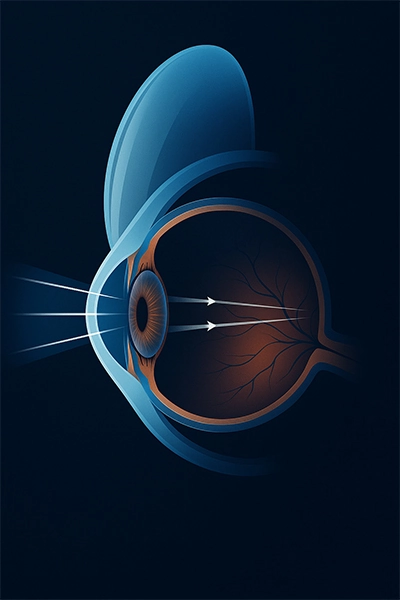
What is astigmatism
An abnormal curvature of the cornea
Astigmatism is a visual defect caused by an irregularity in the curvature of the cornea (or, in some cases, the lens). In a healthy eye, the cornea has a perfectly spherical shape, similar to a ball. In an astigmatic eye, however, the surface has an oval or elliptical shape, like a rugby ball. This causes distorted focusing of light on the retina.
Effects on vision
Due to the irregular curvature, the eye cannot properly focus images, which appear blurred, doubled, or distorted, both at a distance and up close. Unlike myopia or hyperopia, astigmatism can impair vision at all distances.
Types of astigmatism
Myopic astigmatism
This occurs when astigmatism is associated with myopia. In this case, distance vision is further compromised.
Hyperopic astigmatism
When combined with hyperopia, it makes focusing difficult both up close and at a distance.
Mixed astigmatism
In this case, one meridian of the eye is myopic and the other is hyperopic. This is the most complex form.
Symptoms of astigmatism
Blurred or distorted vision
Images appear distorted or doubled, especially the edges. Subjects notice difficulty in distinguishing fine details, such as reading text or recognizing faces from a distance.
Visual fatigue
The eye tries to compensate for the distortion, causing eye strain, burning, headaches, and visual discomfort after prolonged reading, device use, or driving.
Nighttime difficulties
Night lights may appear haloed or have light trails. This complicates driving in low-light conditions.
Problems in children
In younger children, it can affect school performance and daily activities. They often cannot explain what they see but show disinterest in reading or a tendency to get very close to objects.
Uncorrected astigmatism: consequences
Ignoring astigmatism can lead to worsening symptoms, development of amblyopia (lazy eye in children), and reduced quality of life. Early diagnosis is crucial.
Continue reading
FAQ
- Can astigmatism worsen over time?
Yes, especially if not corrected at a young age or if associated with other visual defects. - Is it possible to have only astigmatism?
Yes, although it often occurs in combination with myopia or hyperopia. - Can children have astigmatism?
Absolutely yes, and it must be diagnosed as early as possible to avoid future problems.